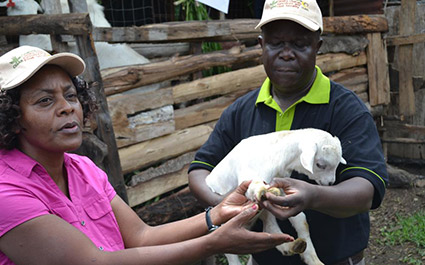 Its copious fur and big ears make it look like half a goat, half a sheep.
Its copious fur and big ears make it look like half a goat, half a sheep.
The new animal being bred by farmers in Nyando, Kisumu County, has become a sensation. The animal is a cross between the Small East African (SEA) goat and the Galla goat.
“In the long run, it will be referred to as the Nyando Composite Goat,” says Julie Ojango, an animal genetics and breeding scientist at the International Livestock Research Institute (ILRI).
“It is resilient to the prevailing climatic conditions, and produces more milk than the local breeds.”
The cross-breed takes the characteristic of the SEA and Galla goats.
The SEA goat has a small body and is hardy, which makes it able to survive in both dry and arable areas, however, it produces about a litre milk.
On the other hand, the Galla or Somali goat, a native of Northern Eastern Kenya, is a queen of milk and does well mainly in arid areas.
WET CLIMATE
“We combined the two animals to get a breed that can suit well in the region,” says Julie, who has been working with colleagues from ILRI and the local community with support from Consultative Group on International Agricultural Research’s (CGIAR) Program on Climate Change, Agriculture and Food Security (CCAFS) in Nyanza and Kericho to come up with the new breed.
Julie, who is one of the lead researchers in the ongoing project, says that after about eight goat improvement projects in several years, it is evident that the Galla goat is the best for crossing with others.
It has a bigger body and produces at least two litres of milk a day, far more than the SEA goat. A mature female Galla goat weighs between 45 and 55kg while the male weighs up to 70kg.
An adult male SEA goat, on the other hand, weighs between 30 and 40kg while a female weighs from 25 to 30kg, and they eat less because of their small bodies.
Pure Galla goats are docile, easy to handle but do not like cold wet climate like that in Nyando plains, which often experiences flooding. Instead, they thrive best in low altitude, preferably in acacia bush country.
“Our resultant breed grows into a bigger animal almost the weight of the Galla breed, it produces an average of 1.5 litres of milk a day, and above all, it is adapted to the local climatic conditions, which is an important attribute sourced from the SEA goat breed,” says Ojango.
Though the Nyando Composite Goat is yet to be tested outside the region, the scientists say it may easily thrive in many areas all over the East African region because it has characteristics of the SEA and Galla goats, that includes climate adaptability.
DISEASES
So far, 22 farmers in Nyando have crossed their SEA goats with the Galla breed, and 1,597 crosses have been recorded and tagged in the past two years.
“Each offspring is tagged to ensure that we study their characteristics as we move forward,” says James Audho, a research assistant at ILRI.
Participating farmers keep records of the Nyando breed to monitor how the animals are faring.
“If they fall sick, then they have to record that because we want to know what kind of diseases affect them. In case of any treatment, it has to be recorded because we need to document the cost of producing the animals to peg a price on them.”
Joshua Omolo is among farmers keeping the new breed. “I like it because it has a big body and it fetches more money in the market. They produce more milk, but above all, they feed on a wide range of vegetation, which gives me several options especially during dry seasons,” says the 38-year-old farmer in Obinju village, Nyando sub-county.
